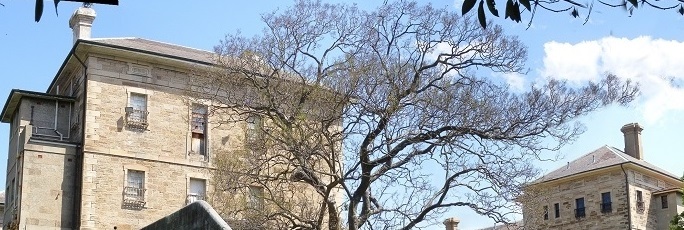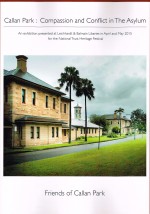… Virginia Macleod PHA (NSW & ACT) introduces a new book by Roslyn Burge, Callan Park: compassion and conflict in the asylum, Friends of Callan Park, Rozelle, 2015
When Professor Paula Hamilton, President of Oral History NSW launched this book in August she reflected on what Callan Park means: it is more than an assemblage of architectural form – buildings and landscape – it provides a foil for many-facetted recollections. She drew on the evocative power of sounds and their association with memory as captured in oral history interviews: the ominous clunking of large keys locking ward doors; and the raucous peacocks at Broughton Hall.
This attractive book is the result of Roslyn Burge’s interviews, conducted over many years. Under the title Rozelle Hospital Oral History Project these are archived at Leichhardt Library and in the State Library of NSW. They formed the basis of an exhibition at Leichhardt Library which proved so popular that this book was produced. Following the exhibition format, topics are arranged thematically and an aerial photograph shows the three spaces: Callan Park, Broughton Hall and Broughton Hall Day clinic which together cover 61 hectares.
Contrasts are strong in this volume; stylish buildings designed with lofty ideals of asylum, counterpoised with a system of incarceration and extreme physical control. Memories of horror and degradation are juxtaposed with care and humanity.
Many in the audience had their own association with Callan Park. They came as ‘wounded sparrows and left soaring as eagles’, reflected former NSW governor Dr Marie Bashir, recalling the young people she cared for as the first psychiatrist at Broughton Hall adolescent unit. Compassion, and humour, permeated her memories.
Peter Gray, who spoke at the launch as a Friend of Callan Park, arrived there as a 17-year-old, a little wild. He was locked in maximum security Ward 2. Details of his treatment, though typical of many large mental institutions in the early 1970s, were utterly saddening. Life revolved around a mixture of regular beatings for misbehaviour, and occasional rewards such as going to church or being allowed to visit the gardens. He feels this environment was still preferable to being in juvenile detention and that his encounters at Callan Park broadened his outlook on life. He especially remarked on the delight of looking across the grounds to the water and to the distant northern shore. It was the place where he grew to adulthood and from which he was eventually released into the world.
Families lived at Callan Park and children grew up with the delights of empty roads to cycle on, grounds to roam, and the smell of the pigs fattened on food scraps at the Callan Park farm. By day patients waved and called from behind bars, they worked in the gardens, maintaining the infrastructure, and helped on the farm and in staff homes. All the noise and activity contrasted with the silence at night.
Local residents and people from far and wide have fought to save Callan Park from demolition or transformation into a gated residential area. It closed as a hospital in 2008 and since then has been used as a park. Much enjoyment is derived from the gardens developed by the first director of Broughton Hall, Dr Sydney Evan Jones who created ‘ornamental elements as a decoration and distraction for patients’.
[Book cover photograph by Ian Hoffstetter]
This article first appeared in the thirteenth edition of Historia, the e-bulletin of Professional Historians Australia, the peak body for Australian Professional Historians Associations.


This is great. The History nee3ds to be told. Unfortunately our current “Leaders” will not learn from History, a sad tale of neglect.
I too will publish a book in Sept 2016 on the rise and fall of Callan Park.